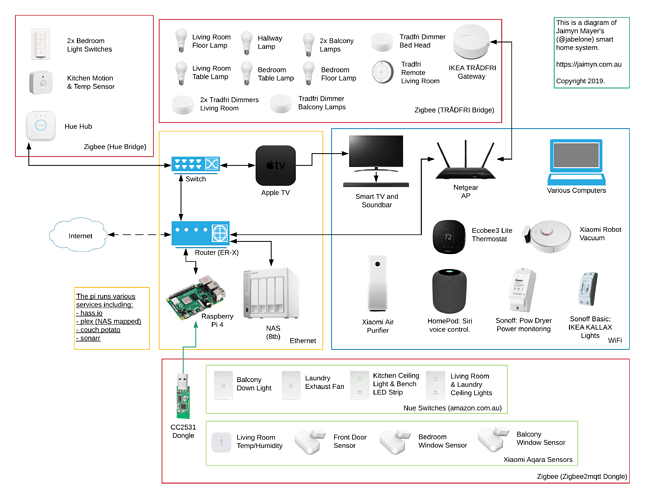I’ve been an eager smart home (or home automation) enthusiast for a number of years now. My end goal is always changing, but it’s generally been to automate as many things as possible and make it as convenient as possible to control all of my lighting and appliances. My smart home system has grown to be quite complex so I’ve started documenting it.
To start with, I’ve put together a system diagram showcasing all of the different components and how everything is connected.

Here is a quick summary of all the different protocols and the different components that rely on them.
ZigBee – CC2531 Dongle (zigbee2mqtt)
Zigbee2mqtt is a fantastic open source project. It aims to bring together all the products from various companies so they can all use a single hub. Currently most vendors have a proprietary hub and there’s little compatibility between. This is surprising given ZigBee is an open standard just like WiFi. Zigbee2mqtt has a set of converters that allow you to add support for almost any device and expose a control/status API over MQTT.
ZigBee is “created on IEEE’s 802.15.4 using the 2.4GHz band and a self-healing true mesh network”. It’s especially ideal for sensor and IoT networks as it is a true mesh network that re-organises itself and relays messages between nodes. It’s also extremely low powered which makes it great for tiny battery powered sensors.
I’m slowly moving all of my ZigBee devices onto this network. This allows me to benefit from having less hubs and a bigger, more reliable ZigBee network. Most of my fixed LED downlights have ZigBee light switches that act as repeaters as they’re always powered.
ZigBee – Phillips Hue
Although they’re great, I’m migrating away from the Phillips hue lineup to the IKEA range for consistency reasons. Otherwise, the hue range is the best quality and functioning smart bulbs I’ve used.
ZigBee – IKEA TRÅDFRI
IKEA’s range of smart lighting products is absolutely fantastic. They are incredibly good value, great quality and work well. You can get a dimmable smart bulb for about $15 AUD!
IPv4 – WiFi/Ethernet
All of the ZigBee hubs connect back to hass.io (or home assistant) over a standard IP network using WiFi or Ethernet. There are also various other devices like my air purifier, robot vacuum cleaner, smart thermostat and a couple of WiFi based relays (sonoff). I try to avoid adding WiFi based IoT devices as a lot of them have serious security vulnerabilities. ZigBee is generally much more secure as a breach from any ZigBee device generally can’t give access to the entire IP network.
Raspberry Pi 4
Home Assistant (or hass.io) runs on my raspberry 4 and exposes all of the devices in my smart home system to HomeBridge. This makes everything available to the Apple ecosystem via HomeKit. This allows me to use Siri or the Home app on my watch, iPhone, MacBook, iPad or HomePod to control everything that’s part of my smart home system. This is really convenient and Siri is now the primary way I interact with my smart home system and control lights/other devices.
The Raspberry Pi 4 also hosts several services such as a plex media server and download server. It’s mapped to our NAS which has 8tb of network accessible storage for media, backups and other files.
Conclusion
My smart home system is a lot of fun to build and maintain but it’s not for everyone. Hopefully this post has given you some ideas on how to get started or improve your own smart home.